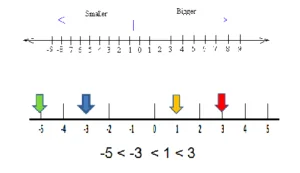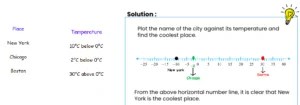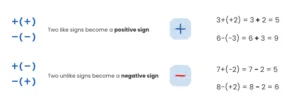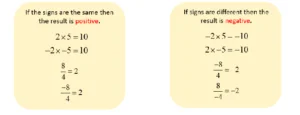
Introduction to Directed Numbers | Cambridge IGCSE Mathematics
[Please watch the video attached at the end of this blog for a visual explanation of factors and multiples]
As an often-question sub-topic under the main topic numbers, today we will focus on directed numbers. As this is a topic that will appear integrated with other topics at an exam, it won’t be a long topic, but that does not mean it is no less important! In fact, you need to have the basics of directed numbers down in order to attempt most of the other questions.
What are Directed Numbers?
Directed numbers are quite simply, numbers with both size and direction. This means that they have a value ( 2, 62, 104, etc), as well as a direction (either positive numbers or negative numbers on a number line). They are also called integers.
Example of directed numbers:
Temperature -
We often talk about how the temperature in one place is higher or lower than the temperature in another place, and to indicate this, we use positive and negative numbers, a.k.a directed numbers!
Comparison of directed numbers
If we break it down into more detail, one of the most important things you must learn is the ability to compare numbers. Sounds simple right? While there are some small details to pay attention to, it really is that simple!
There are positive directed numbers and negative directed numbers and If you look at the number line given below, you should be able to put it on a basic timeline.

We can see that for example, positive three (+3) is greater than positive one (+1). Three is bigger than one normally, but in the case of negative numbers, although negative three (-3) might look smaller than negative five (-5), it is actually bigger than negative 5 (-5).
Therefore, negative five (-5) is the smallest number, and then negative 3 is bigger than negative five, positive one is bigger than negative three, and positive three is bigger than positive one.
-5 < -3 < 1 < 3
You need to be very careful when handling the order of negative numbers.
Remember,
Negative numbers, the bigger they get, the smaller they are, positive numbers, the bigger they get, the larger they are (in value),
Question
Attempt the question below and see if you can get the answer right. Refer to the explanation in case you got it wrong, and you will be able to compare numbers in record time!

Answer explained:
You can see that New York is 10 degrees below zero degrees, so that means it is at negative 10, that’s why we put a black dot for New york qat negative 10 (-10) and Chicago is 2 degrees below zero degrees, which means it’s negative two degrees, hence Chicago is marked in green as negative two degrees (-2), and Boston is 30 degrees above zero degrees, so we can put Boston all the way up there and the red point of 30 degrees (30).
This is the most basic and simplest type of questions you might be able to face in examinations and as this topic is often integrated with other topics, it’s not something tested separately
What are the rules regarding directed numbers?
There are certain rules that must be followed when adding, subtracting, multiplying and dividing directed numbers.
Addition and subtraction of directed numbers
- When you add two positive numbers, the answer is positive, and when you subtract a negative number from a positive, it’s also going to turn into a positive number.
Ex:
3 plus positive 2 is going to be 5,
3 + (+2) = 5
- If a positive number subtracts a negative number, the answer will be a positive number, as the two negative signs will result in a positive sign.
Ex:
6 subtract negative three is going to be 9
6 - (-3) = 6 + 3 = 9
So it’s very important that you remember that subtracting a negative number results in a positive number.
- At the same time, if you are either adding a negative number or you are subtracting a positive number, then the final answer is like a basic subtraction.
Positive 7 plus negative 2 is the same as saying 7 subtract 2
7 + (-2) = 5
Positive 8 subtract negative 2 is the same as saying 8 subtract 2
8 - (+2) = 6
Therefore two key takeaways from this part of the lesson is that:

Multiplication and division of directed numbers
Multiplication and division rules regarding directed numbers are very important as well.
- If you multiply a positive number with a positive number, then the answer is a positive number. Likewise, if you multiply a negative number with a negative number, even then the answer is a positive number.
Positive two multiplied by positive 5 is 10
2 ✕ 5 = 10
Negative five multiplied by negative 2 is 10
(-5) ✕ (-2) = (+) 10
- If you divide a positive number by a positive number, then the answer is a positive number. Likewise, if you divide a negative number by a negative number, then too, the answer is a positive number.
Positive eight divided by positive 4 is positive 2
8 ➗ 4 = 2
Negative eight divided by negative 4 is positive 2
(- 8) ➗ (- 4) = 2
If the signs are different, that is if either one of the numbers are negative, then the answer is always negative. The first number can be negative, or the second number can be negative, but as long as one number is negative then the answer is also negative.
- If you multiply a positive number with a negative number, then the answer is a negative number,
Negative five multiplied by positive two is negative 10.
( -5) ✕ (+2) = - 10
Negative two multiplied by positive positive five is also 10
( -2) ✕ (+5) = (+) 10
- If you divide a positive number by a negative number, or a negative number by a positive number, the answer is going to be negative.
Negative eight (-8) divided by positive 4 is negative two (-2)
(- 8) ➗ 4 = - 2
Positive eight divided by negativefour (-4) is negative two (-2)
8 ➗ (-4) = - 2

Remember:
Like signs (positive and positive or negative and negative) give you a positive answer, whereas different signs (positive and negative) give you a negative answer!
Helpful points for practising directed numbers for your upcoming Cambridge IGCSE Mathematics exams.
Mathematics is a subject that relies heavily on how well you prepare in advance for your exams. To make things easier, here are a few pointers that may help you get ready for your upcoming Cambridge IGCSE Mathematics exams.
Study the directed numbers and what the process is when it comes to adding, subtracting, multiplying and dividing directed numbers, both positive and negative.
Practice sample questions – Practise, practise, practise. Questions on factors and multiples can be both simple and hard, so do both types of questions for good measure. Our question banks have questions of different difficulty levels that you can practise before your actual exams.
Practise past paper questions to familiarise yourself with the format of the questions and paper.
Ask for help – You are never too late to ask for assistance if you’re struggling. Reach out to us at Tutopiya to find the right tutor to help you pass your exams with flying colours!
Watch the video below for a visual explanation of directed numbers and attempt the quiz to challenge yourself!
Written by
Tutopiya Team
Educational Expert
Related Articles

What’s Next After A-Levels? Figuring Out Your Next Step
Comprehensive guide and expert insights on educational topics for IGCSE, IB, and international curriculum students.

IGCSE Economics Revision Resources, Past Papers, and More
Master IGCSE Economics with essential revision resources & past papers. Ace your exams with global support. Ideal for IB & A-level students too.

Why Personalized Learning Beats Group Classes for IGCSE
Comprehensive guide and expert insights on educational topics for IGCSE, IB, and international curriculum students.


